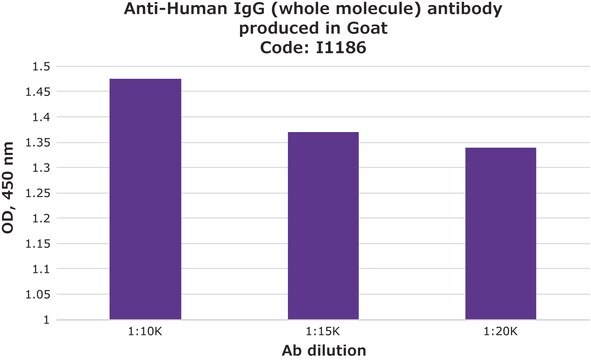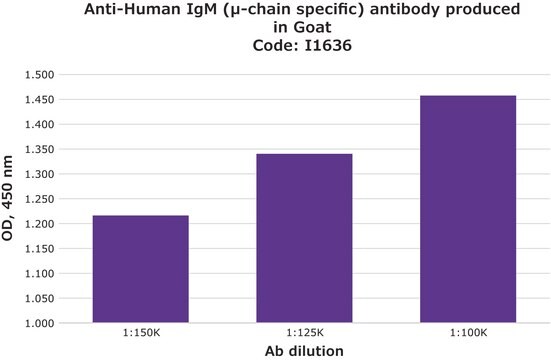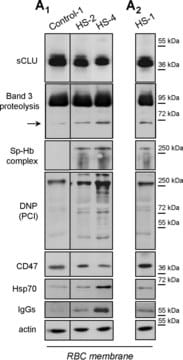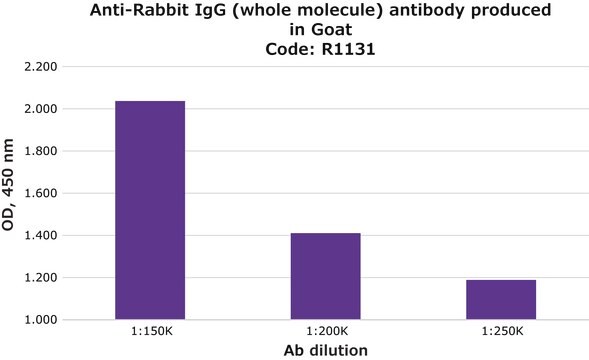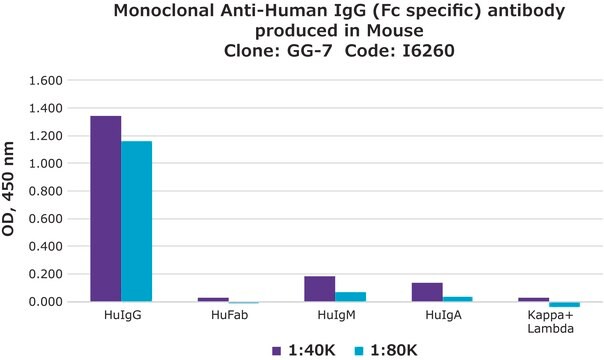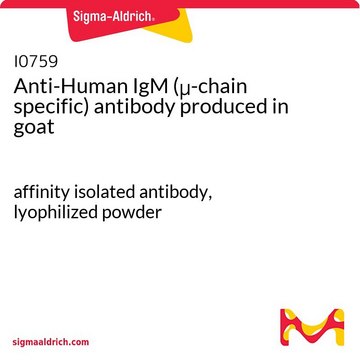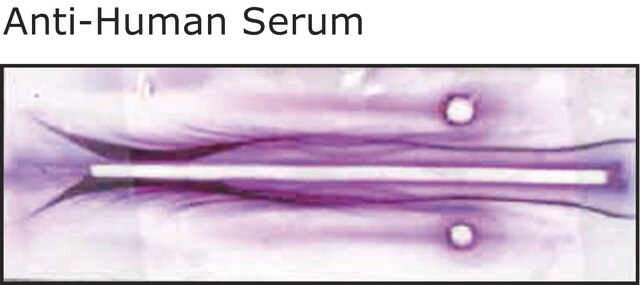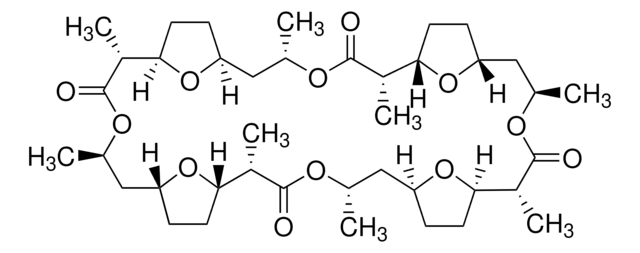I1011
Anti-Human IgG (whole molecule) antibody produced in goat
whole antiserum
Sinonimo/i:
Anti-Human IgG, Goat Anti-Human IgG
Autenticatiper visualizzare i prezzi riservati alla tua organizzazione & contrattuali
About This Item
Prodotti consigliati
Origine biologica
goat
Livello qualitativo
Coniugato
unconjugated
Forma dell’anticorpo
whole antiserum
Tipo di anticorpo
secondary antibodies
Clone
polyclonal
contiene
15 mM sodium azide
tecniche
indirect ELISA: 1:40,000
quantitative precipitin assay: 4.0 mg/mL
Condizioni di spedizione
dry ice
Temperatura di conservazione
−20°C
modifica post-traduzionali bersaglio
unmodified
Cerchi prodotti simili? Visita Guida al confronto tra prodotti
Descrizione generale
IgG is present in large quantities in the human serum. It constitutes about 10-20% of the plasma proteins. IgG is composed of glycoproteins, out of which it is 82-96% proteins and 4-18% carbohydrates. It consists of four sub-classes i.e IgG1, IgG2, IgG3, and IgG4. IgG is composed of four polypeptide chains-two heavy chains (γ chains) and two light chains (κ or λ chains) which are linked by inter-chain disulfide bonds. The heavy chains consist of a N-terminal variable domain (VH) and three constant domains (CH1, CH2, CH3). A hinge region exists between the CH1 and CH2 region. The light chains have one N-terminal variable domain (VL) and one constant domain (CL). The heavy and the light chains are linked at VH and CH1 domain to form the Fab arm (Fragment antigen binding). The antigen binds to the V regions of the antibody.
Applicazioni
Anti-Human IgG (whole molecule) antibody has been used in
- enzyme linked immunosorbent assay (ELISA)
- printing and processing of reverse phase protein microarrays
- western blot
- radial immunodiffusion
Azioni biochim/fisiol
IgG antibody subtype is the most abundant serum immunoglobulin of the immune system. It is secreted by B cells and is found in blood and extracellular fluids and provides protection from infections caused by bacteria, fungi and viruses. Maternal IgG is transferred to fetus through the placenta that is vital for immune defense of the neonate against infections.
IgG, a monoclonal antibody can be cleaved at the hinge region by nonspecific proteases like papain and pepsin. This can result in univalent Fab fragments or bivalent F(ab′)2 fragments. These two enzymes have a broad substrate specificity resulting in heterogenous fragments.
Stato fisico
Anti-Human IgG is supplied as a liquid containing 15 mM sodium azide as a preservative
Stoccaggio e stabilità
For continuous use, store at2-8 °C. For extended storage, the solution may be frozen in working aliquots. Repeated freezing and thawing, or storage in "frost-free" freezers,is not recommended. If slight turbidity occurs upon prolonged storage, clarify the solution by centrifugation before use.
Esclusione di responsabilità
Unless otherwise stated in our catalog or other company documentation accompanying the product(s), our products are intended for research use only and are not to be used for any other purpose, which includes but is not limited to, unauthorized commercial uses, in vitro diagnostic uses, ex vivo or in vivo therapeutic uses or any type of consumption or application to humans or animals.
Non trovi il prodotto giusto?
Prova il nostro Motore di ricerca dei prodotti.
Codice della classe di stoccaggio
10 - Combustible liquids
Classe di pericolosità dell'acqua (WGK)
nwg
Punto d’infiammabilità (°F)
Not applicable
Punto d’infiammabilità (°C)
Not applicable
Scegli una delle versioni più recenti:
Possiedi già questo prodotto?
I documenti relativi ai prodotti acquistati recentemente sono disponibili nell’Archivio dei documenti.
I clienti hanno visto anche
Pyruvate kinase M2 and the mitochondrial ATPase Inhibitory Factor 1 provide novel biomarkers of dermatomyositis: a metabolic link to oncogenesis
Santacatterina F, et al.
Journal of Translational Medicine, 15(1), 29-29 (2017)
Evaluation of the immune humoral response of Brazilian patients with Rubinstein-Taybi syndrome
Sugayama S M M, et al.
Brazilian journal of medical and biological research, 43(12), 1215-1224 (2010)
Parmjeet S Randhawa et al.
Clinical and vaccine immunology : CVI, 13(9), 1057-1063 (2006-09-09)
Immunoglobulin G (IgG), IgA, and IgM antibodies were measured in serum samples from 71 organ donors, 81 kidney transplant recipients at transplantation, and 67 patients during the posttransplant period by using a virus-like particle-based enzyme-linked immunosorbent assay (ELISA). BK virus
The role of Fc-receptors in the uptake and transport of therapeutic antibodies in the retinal pigment epithelium
Dithmer M, et al.
Experimental Eye Research, 145(1), 187-205 (2016)
L C Torres et al.
Brazilian journal of medical and biological research = Revista brasileira de pesquisas medicas e biologicas, 43(12), 1215-1224 (2010-11-19)
Rubinstein-Taybi syndrome (RTS) is a rare developmental disorder characterized by craniofacial dysmorphisms, broad thumbs and toes, mental and growth deficiency, and recurrent respiratory infections. RTS has been associated with CREBBP gene mutations, but EP300 gene mutations have recently been reported
Il team dei nostri ricercatori vanta grande esperienza in tutte le aree della ricerca quali Life Science, scienza dei materiali, sintesi chimica, cromatografia, discipline analitiche, ecc..
Contatta l'Assistenza Tecnica.